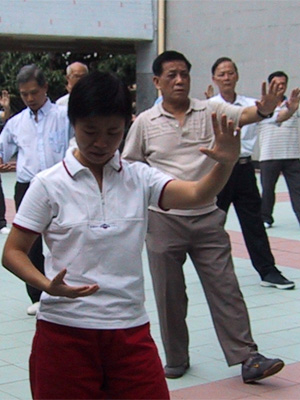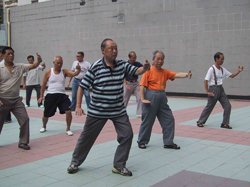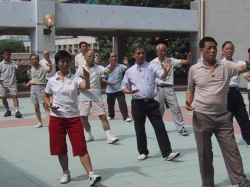Brief Introduction and Statistics
|
Physical Activity is defined as all movements in everyday life, including work, activities of daily living, recreation, exercise and sporting activities. Exercise is a subcategory of leisure time physical activity in which planned, structured, repetitive bodily movements are performed.
According to the local Healthy Living Survey in 1999, 51% male and 47% female had engaged in sports or exercise within the previous month. It also indicated that younger people had the highest participation rate and it dropped with age. However, among those had regular participation in exercise, the frequencies for younger people were lower than that for older people. From another study, the Physical Activity in Hong Kong Chinese Adults in 2001, it was found that about 36% adults were sedentary in terms of physical activity level and only 23.7% were physically active to achieve significant health benefits. The initial findings of the Millennium Sports Study (first phase study in 2002-03) also revealed that only 17% of individual adults in Hong Kong engage in enough physical activity to maintain health and prevent disease. All the above findings indicated that the physical activity level of local people lags behind world standards.
|
 |
|
Overview
- Benefits of Exercise for Older Adults
- Type, Frequency, Duration and Intensity of Exercise
- Warm-up and Cool-down
|
 |
|
 |
- Safety Concern
- Motivation (From Sedentary to Active Lifestyle)
- Exercise and Diet
- Related websites
|
|
Benefits of Exercise for Older Adults
|
Physical active lifestyles benefit people throughout the lifespan. The beneficial effects apply to most individuals regardless of health status or disease state. There is ample evidence to demonstrate that physical activity and exercise are associated with significant improvements in functional ability and health status as well as frequently prevent certain diseases or diminish their severity in the geriatric population. The following is a list of benefits of participating in regular physical activity or exercise especially for the elderly:
• Improve physical fitness.
• Improve life expectancy.
• Control body weight by countering loss of muscle and countering gain in fat.
• Improve heart and lung fitness.
• Reduce risk of developing certain diseases and health problems common in old age such as heart disease, hypertension, diabetes, osteoporosis, bone fractures and cancer.
• Reduce feeling of depression and anxiety while improving mood state and self-esteem.
• Improve quality of life.
Type, Frequency, Duration and Intensity of Exercise
|
It is recommended that 30 minutes of moderate intensity physical activity everyday is beneficial to health. Recent research has demonstrated that the health benefits can also be derived from the accumulation of exercise for such time and intensity. It means that the 30 minutes session can be divided into 2 or 3 sessions throughout the day with 15 or 10 minutes per session respectively.
A balanced activity program for older adults should incorporate four basic types of exercise – endurance , strength, balance and stretching . Each type of exercise has its own benefits and characteristics. The following table summarizes the exercise recommendations for older adults.
|
Endurance Exercises |
Strength Exercises |
Balance Exercises |
Stretching Exercises |
Health Benefits |
Improve the health of your heart & lungs
Improve your stamina |
Strengthen your bones & muscles
Ease of arthritis pain |
Reduce risk of falls & fractures |
Increase flexibility of movement
Improve posture |
Activity/ Exercise Examples |
Walking
Swimming
Cycling on a stationary bicycle
Bicycling
Ball games
Dancing
Scrubbing floor |
Lift or push weights by major muscle groups(*)
Working with pulleys |
Tai Chi
Tandem walking
Standing on 1 leg
Climbing up & down steps slowly
Standing on heels & toes |
Tai Chi
Stretching of major muscle groups (+) |
Frequency |
3-7 days/week |
2-3 days/week |
1-7 days/week |
1-7 days/week
|
Amount |
20-60 min/session |
1-3 sets of major muscle groups with 8-12 repetitions for each muscle group |
15-30 min/session |
20 sec for one sustained stretch, 3 times for each muscle group |
Progression |
Increase amount of time for activity
Increase the speed for activity |
Increase amount of weight |
Increase in difficulty e.g. from holding onto a table or chair by hand(s) during balance exercise to that without holding on at all |
Stretch farther gradually, but not so far that it hurts |
Safety |
Take adequate liquids to prevent dehydration
Perform warm-up & cool-down activities before after the activity
Wear stable shoes especially during walking |
Slow, smooth & steady movement
Avoid thrusting weights into position
No breath holding
Breathe out as you lift or push, and breathe in as you relax
Do not do the same muscle group on any 2 days in a row |
Ensure safe environment
Have someone stand close by if you are unsteady
|
Perform stretching with slow & steady movement
Avoid stretching too far (i.e. pain sensation) |
( *) Major muscle groups for strength exercises: shoulder muscles, upper arm muscles (biceps & triceps), upper & lower back muscles, hip muscles, thigh muscles, calf muscles, ankle muscles.
(+) Major muscle groups for stretching exercises: neck muscles, shoulder muscles, upper arm muscles, wrist muscles, hip muscles, thigh muscles, calf muscles, ankle muscles.
• Warm-up and cool-down are two important parts of a safe exercise program. They should be performed for
5 to 10 minutes at the beginning and the end of each session.
• During the warm-up and cool-down periods, stretching of muscles from neck to ankle are required.
Stationary stepping or slow walking may also be performed especially after endurance exercises.
• Purposes of warm-up activities:
i) prepare the heart & lungs for the increased demand of exertion.
ii) enhance flexibility of joints & muscles to prevent their damage from exertion by exercises.
• Purposes of cool-down activities:
i) slowly settle the heart rate back to normal.
ii) prevent muscle stiffness.
► Virtual class for fitness exercise for older persons
(Healthy Exercise for All Campaign, Leisure & Cultural Services Department)
A common misunderstanding among people is that exercise is excessively risky in later life. They concerned about the risk of developing heart attack or injuring a body unused to such activity. These fears are often unwarranted. Almost all older persons can participate in moderate physical activities safely. There is no evidence that increased activity causes problems if the heart is healthy. Heart disease is partly caused by inactivity together with other risk factors. In fact, people who have regular exercise throughout their lives are less likely to suffer a heart attack than those who are lack of activities. Moreover, injuries to muscles, ligaments and joints are more common in people who exercise infrequently than those with regular exercise. Sprains or painful sensation arising from exercise are usually the result of inadequate preparation or excessively intense and prolonged activity. The following are some practical tips to ensure exercise safety:
• Remember to do warm-up and cool-down activities before and after exercise.
• Wear non-slippery and impact-absorbing shoes.
• Wear comfortable and light-weight clothing.
• Avoid exercise just after taking a meal.
• Drinking before, during and after exercise to prevent dehydration.
• Engage in the moderate exercise program first by starting slowly and gradually increase the duration and intensity of activity to the recommended level over a period of weeks or months.
• Stop exercise when sprain or injury occurs.
• Seek help from doctor immediately if extreme pain, significant chest pain after exertion, severe bruising or joint deformity is developed.
• Seek advice from your doctor or therapist before starting exercise program if any chronic medical problem such as heart disease, hypertension, diabetes mellitus and arthritis is present or you have not exercised for a long period of time.
Motivation (From Sedentary to Active Lifestyle)
|
Most of the general public has been educated to believe that exercise is beneficial, but only some of them have sufficient exercise. Many older adults are even reluctant to change their present comfortable but sedentary lifestyle. Extra motivation may be required to incorporate exercise into their daily lives and make it become a regular habit. The following are some suggestions of motivating factors in initiating and sustaining exercise:
• Exercise with companions such as families, friends or in a group.
• Have choices in participating in enjoyable and fun exercise.
• Set simple and realistic goals and reward for achievement.
• Be aware of any improvement and appreciate your efforts.
• Allow flexibility and variety of exercise's options.
• Emphasize and take notice of improved health status and well-being.
Exercise and diet are interrelated. A health benefit is apparent with both positive changes in exercise and diets for promoting general health and reducing risks for specific diseases. Studies have demonstrated that exercise can lead to a 1 to 4% loss of body fat. When weight loss is contributed only by reduction on calories intake, muscle is lost as well as fat, and this can lead to markedly diminished strength in older persons who already have loss of muscle mass and strength with aging. Prominent effect on weight loss and favorable body composition and fat distribution will be obtained by both exercise and dietary changes.
|

